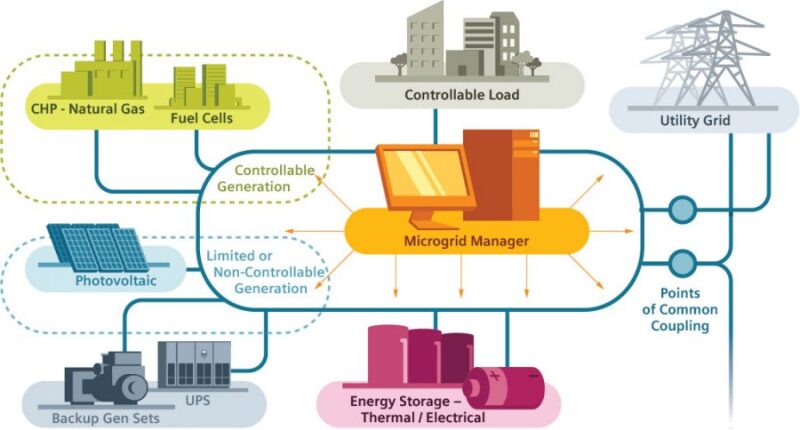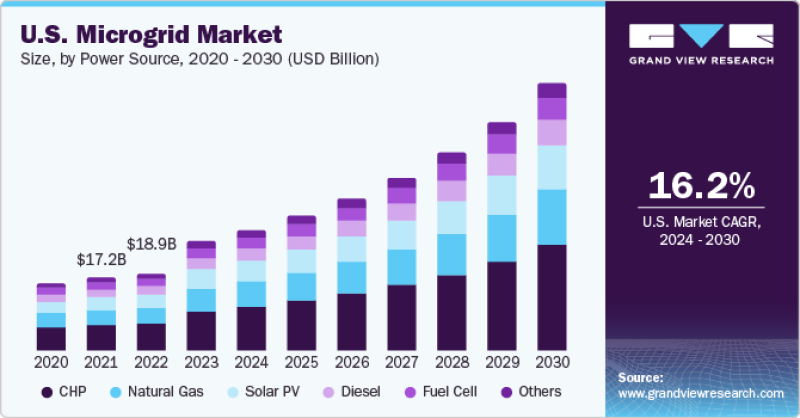In a world facing intensifying climate risks, increasing energy demands, and widening access disparities, the centralized power grid model is struggling to keep pace. Traditional grids are often inflexible, susceptible to failure during natural disasters, and inadequate for integrating variable renewable energy at scale. As these instances become more common, microgrids offer a decentralized solution tailored for resilience and adaptability. They not only strengthen local energy autonomy but also enable communities, businesses, and institutions to reduce dependence on fossil fuels and centralized infrastructures.
A microgrid is an autonomous energy system that can operate independently from the main grid or in parallel with it. Composed of renewable energy sources (solar, wind, hydro, etc.), storage systems (such as batteries), and smart management technologies, a microgrid can produce, store, and distribute energy efficiently. This can help reduce costs and improve performance. Moreover, microgrids can be very useful because of their plug-and-play functionality, providing stability to the network and energy during blackout periods.
From Centralized Grids to Decentralized Systems: The Evolution Toward Microgrids
Historically, electricity generation and distribution followed a top-down model: large power plants located far from consumers delivered energy through vast transmission networks. This structure, designed for a fossil fuel-based economy, prioritized scale and uniformity but came with high transmission losses, vulnerability to disruptions and limited flexibility. The limitations of this approach became evident with growing urbanization, electrification of remote areas, and a surge in renewable energy production.
As early as the 1980s, isolated power systems and localized grids began to emerge in rural and island settings. With advancements in solar photovoltaic (PV) systems, battery storage, and smart controls, these systems evolved into today’s microgrids—flexible, intelligent, and clean energy networks. What began as a workaround in off-grid regions is now a forward-looking model reshaping energy architecture across the globe (Fig.1).

Microgrids are particularly useful in remote or vulnerable areas where energy access is limited, or the main grid is unstable, proving reliability and resilience. In urban environments, they also support critical services—like hospitals and emergency centers—during outages, a value proven during extreme weather events such as Hurricane Sandy (Pacific Northwest National Laboratory, 2023).
Secondly, they enable more efficient energy distribution. With the use of AI-powered grid controllers, microgrids can balance load, forecast demand, and reduce energy waste in real time.
In the context of energy transition, microgrids can be powered by renewable sources, which helps to reduce greenhouse gas emissions and promote energy self-sufficiency. This makes them a cornerstone of net-zero strategies for communities and industries alike. Their projected growth can be seen in Fig. 2.

They also promote a circular economy model, where locally produced energy is consumed locally, reducing the need for long-distance transportation and distribution. They also stimulate local economic growth by supporting energy independence and local job creation in installation and maintenance.
The Shift From Passive Consumers to Active Prosumers
One of the most transformative aspects of microgrids is the empowerment of end-users to become "prosumers"—individuals or organizations that both consume and produce energy. This shift fundamentally redefines the traditional energy dynamic, allowing users to generate electricity via rooftop solar panels or wind turbines, store it, and even sell excess power back to the local grid.
In Brooklyn, New York, the Brooklyn Microgrid project, initiated by LO3 Energy, enables residents to engage in peer-to-peer energy trading using blockchain technology. This decentralized energy exchange not only enhances energy equity and autonomy but also drives local investment in renewables. By putting energy control into the hands of consumers, microgrids are accelerating the democratization of energy and promoting a participatory model that aligns with the global push toward sustainability and resilience.
Real-World Applications
The applications of microgrids are numerous and continually expanding. From energy for remote islands to manage distribution in urban neighborhoods and industrial applications, microgrids are proving to be essential for flexible and sustainable energy management.
Microgrid projects are developed either at pilot scale and full scale and they involve a wide variety of frameworks including:
- Residential framework: In 2022, one of the UK’s largest energy companies, Centrica, provided microgrids for the residential district, the Grove Park at Sellindge, near Ashford (Kent). The project was led by the housing developer Quinn Estate, and it aims to provide energy exclusively via renewable energy coupled with storage system and a smart grid management controller. A grid controller, developed by SNRG SmartGrids, is designed to work with insite power generation (solar PV on rooftops) and offsite assets. The project relies on a 500-MW zero-carbon microgrid.
- Industrial example: Siemens has developed an advanced microgrid at its Princeton, New Jersey, campus integrating solar PV, battery storage, and a building automation system. The site serves as a live demonstration of demand response and carbon-neutral strategies.
- Island/remote area example: This kind of framework covers the majority of active projects. On Taʻū Island in American Samoa, Tesla and SolarCity implemented a solar-powered microgrid that replaced the island’s reliance on diesel fuel. The system consists of 5,328 solar panels capable of generating 1.4 MW of electricity, and 60 Tesla Powerpacks for energy storage. It can power the island for up to 3 days without sunlight and has helped eliminate the use of about 110,000 gallons of diesel annually, significantly improving energy resilience and sustainability.
Challenges and Future Prospects
Microgrid technology has risen in the difficult period of energy transition, where sustainability and supply security are pillars. However, they are not without challenges such as:
- Regulatory carriers: Utility regulations in many regions have not yet been adapted to support grid defection or peer-to-peer energy trading.
- High initial investment: Although long-term benefits are substantial, upfront costs for infrastructure and storage can be a barrier. Innovative financing, such as energy-as-a-service models, is increasingly used to overcome this.
- Interconnection complexity: Seamless integration with the main grid, especially in legacy systems, requires significant coordination. Cybersecurity for digital grid components is also a growing concern.
However, the future of microgrids is undeniably bright. As battery technology matures, policies evolve, and climate urgency increases, microgrids will play a pivotal role in transitioning toward resilient, sustainable, and democratized energy systems.
Conclusion
Microgrids are no longer niche innovations—they have become a foundational component of modern energy infrastructure. From remote islands like Taʻū to industrial campuses, microgrids demonstrate their value by delivering clean, reliable, and locally controlled energy.
By seamlessly integrating renewable sources, improving energy resilience, and enabling real-time energy optimization, microgrids help communities and industries meet both sustainability and reliability goals. Ongoing advancements in AI-driven control systems, battery storage, and remote monitoring are rapidly improving the cost-effectiveness and scalability of these systems.
Realizing their full potential will require targeted policy reform, clearer regulatory frameworks, and greater access to innovative financing models. When these barriers are addressed, microgrids will unlock local energy empowerment, promote equity, and enhance climate resilience—making them a strategic pillar of the global energy transition.
For Further Reading
Designing Resilient Decentralized Energy Systems: The Importance of Modeling Extreme Events and Long-Duration Power Outages by R. Hanna and J. Marqusse, University of California at San Diego
Innovative Solutions for 100% Renewable Power in Sweden, IRENA
Are Microgrids a Key to Grid Resiliency? by K. Adkisson, Pacific Northwest National Laboratory
Princeton Siemens Campus, Siemens

Piergiuseppe Fiore is a petroleum engineer at Eni. He is part of the reservoir management and production data analysis unit, working on injectivity issues, improved oil recovery, and carbon capture and storage. He has also specialized in CFD simulations, publishing several articles. Fiore is an active SPE member and is a member of the Young Professionals Board of the SPE Italian Section. He holds an MSc degree in chemical engineering from the University of Calabria and a second-level master’s in petroleum engineering from Polytechnic of Turin.

Khawaja Hasnain Iltaf is enrolled in a PhD program in earth and environmental sciences, with a focus on geochemistry and petrophysics, at The University of Texas at Arlington. His research is primarily focused on the investigation of rock properties, fluid-rock interactions, and geochemical analysis leveraging core data. During his master's program, he has conducted comprehensive facies and petrophysical characterizations of tight sandstone reservoirs employing a blend of stochastic and deterministic methods. He has also held roles as an intern and research assistant across various exploration and production companies and academic institutions. He has authored or coauthored 13 research papers published in international journals, alongside 15 poster presentations and published abstracts at international conferences and workshops. He also serves as reviewer for three peer-reviewed journals and served as technical program reviewer for five international conferences. He served as a PetroBowl volunteer in 2017 and as an SPE student chapter award judge in 2018.

Bhartendu Bhardwaj is a reservoir engineer at Bassein & Satellite Asset at Oil and Natural Gas Corp. based in Mumbai, India. He has more than 10 years’ experience in onshore and offshore field development from conceptualization to implementation of new exploration licensing policy as well as nomination regime. He currently serves as a section officer of the SPE Mumbai Section and is actively associated with section activities. He is also part of the Indian Hydrocarbon Appraisal Program, an initiative by the Ministry of Petroleum and Natural Gas, India. Bhardwaj holds a petroleum engineering degree from Indian Institute of Technology (Indian School of Mines) and a post graduate diploma in business analytics with specialization in finance from Symbiosis International University.

